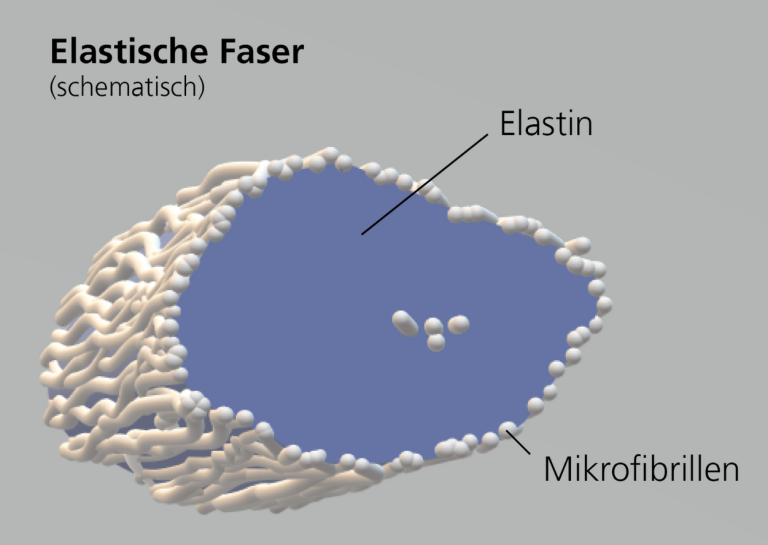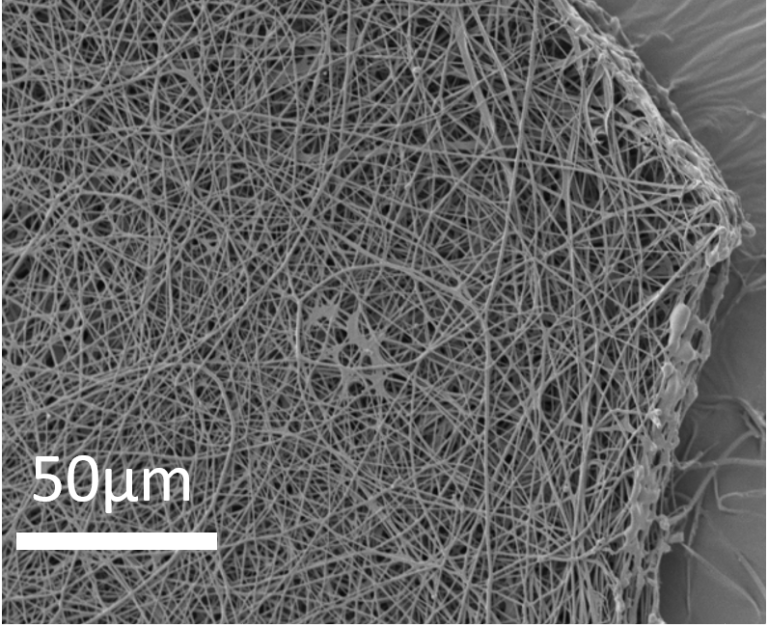Expertise in Elastin

What is elastin and what can I use it for?
- What is Elastin?
- What role does elastin play in skin aging?
- How does elastin affect the skin?
- What is the difference between elastin and collagen?
- matripure® - Elastin for cosmetics
- Can you eat matripure®?
- Elastin in research and development
- What is the difference between matripure® and matripure® A, matripure® B and matripure® N?
- Elastin for Tissue Engineering
What is Elastin?
Elastin is an essential structural protein in connective tissue and the main component of elastic fibers. Elastin is responsible for the elasticity of mechanically stressed tissues and organs (e.g. skin, lungs, blood vessels) and enables them to stretch and contract again. In addition to elastin, collagen occurs in the extracellular matrix (ECM) as another structural and fibrous protein mainly responsible for the tensile strength of tissues. The contrasting mechanical properties of elastin and collagen allow the body to establish tissue-specific resistance through different proportions of elastic and collagen fibers in the extracellular matrix. Elastin, unlike collagen, is not newly formed by the body. Any damage to elastin by external (e.g. UV radiation, injury) or internal factors (e.g. enzymatic degradation, calcification and oxidative damage in the aging process) is irreversible. The degradation of elastin and the associated decrease in elasticity can be observed most clearly in the aging of the skin and the formation of wrinkles. But also other, mostly age-related disease patterns, such as aneurysm formation, are due to elastin damage. Furthermore, age-related diseases (e.g. diabetes mellitus, decubitus, chronic venous insufficiency) usually lead to chronic wounds, which accelerate the degradation of elastin. However, acute wounds also lead to elastin damage and the scar tissue that forms consists exclusively of collagen, which means that scars have no elasticity whatsoever. This leads to a loss of skin function, especially in the case of extensive wounds (e.g. burns), and can have serious consequences for patients. The current market analysis shows a strong focus on collagen-based products, although the combination of both products brings very high customer benefits due to their complementary properties.
The evolution of vertebrates was accompanied by the development of flexible and extensible tissues. This is evident, for example, from the pronounced structural changes in the walls of blood vessels that were required for conversion from an open to a closed circulatory system. The properties of elasticity and extensibility were made possible primarily by the emergence of elastic fibers, which are very abundant in larger blood vessels. The fibers store the potential energy required to maintain blood flow during diastole. In this way, proper cardiovascular function is enabled. Elastic fibers are also found in many other organs that must be reversibly deformable for physiological function. These include the lungs, skin, elastic cartilage or ligaments. Elastic fibers are found in the extracellular matrix (ECM) and consist of an outer sheath of fibrillin-rich microfibrils and a dense core of elastin, which accounts for over 90% of the total volume.
Example blood vessels

Elastic fiber (schematic) consisting of a core and elastin and a sheath of microfibrils.
What role does elastin play in skin aging?
Skin aging is a natural process that occurs over time and is influenced by various factors. One of the important components that influence skin elasticity and firmness is elastin. Elastin is a protein found in the skin and is responsible for its elasticity.
Elastin is an extremely durable material with a half-life of up to 75 years. However, damage to the elastic fibers in skin tissue as a result of degradation processes in the body and external factors, such as UV radiation, leads to degradation of elastin and reduced elasticity of the tissue. The clearest sign of this degradation process is the formation of wrinkles on the skin as aging progresses. Since elastin is not newly formed, this process cannot be reversed. With the help of our elastin, we can give back to the body what it has lost and thus counteract the consequences of the degradation process. As a natural material with proven skin compatibility (HET-CAM), it is ideal for skin applications. Our matripure offers high purity and properties adapted to customer requirements. For example, we offer different structural sizes of elastin that can also be used for scar aftercare. As a soluble and insoluble variant, many other applications are possible, for example in creams, as a dermal filler or in beauty drinks.
Elastin in the skin

Wrinkle formation due to elastin degradation in the skin
How does elastin affect the skin?
Elastin itself does not penetrate deep into the skin as it is a large protein. Cosmetic formulations therefore usually use hydrolyzed elastin (such as matripure®), which has been broken down into smaller peptides and can therefore penetrate better into the upper layers of the skin. The main effects on the skin are:
1. moisture retention: Hydrolyzed elastin has hygroscopic properties, which means it attracts water and helps to hydrate the skin. This contributes to a smoother and more supple skin feel.
2. skin care and protection: Due to its film-forming properties, elastin hydrolyzate coats the skin and can help to reduce moisture loss, which is particularly beneficial for dry or mature skin.
3. support of the skin structure: While elastin in cosmetic products cannot cause a profound regeneration of the skin structure, it still provides a well-groomed, smooth skin appearance and supports the skin in its natural protective function.
4. supplement in anti-aging formulations: Elastin hydrolysate is often used in anti-aging products due to the optical smoothing of the skin surface and the moisturizing effect.
What is the difference between elastin and collagen?
Elastin and collagen are both structural proteins that are important for the elasticity and strength of tissues in the body. However, they differ in their function and structure:
Elastin:
- Function: Gives tissues elasticity so that they can stretch and return to their original shape.
- Occurrence: Particularly in elastic tissues such as skin, lungs, blood vessels and ligaments.
- Structure: Consists of cross-linked tropoelastin molecules that enable a flexible and stretchable structure.
- Property: High elasticity and resilience, similar to a rubber band.
Collagen:
- Function: Provides stability, strength and structure in tissues.
- Occurrence: Main component of skin, tendons, ligaments, bones and cartilage.
- Structure: Fibrous protein with a triple helix structure that provides tensile strength.
- Property: Not very elastic, but very resistant to tensile forces.
Summary:
- Elastin = elasticity and extensibility (e.g. in skin and arteries).
- Collagen = stability and strength (e.g. in tendons and bones).
Both proteins often work together, e.g. in the skin, where collagen provides structure and elastin enables elasticity.
Can you eat matripure®?
Not now! Over 30% of the amino acids that make up elastin are essential amino acids, i.e. amino acids that are required by the body but cannot be synthesized by the body itself. These amino acids must be supplied to the body through food intake. Elastin therefore has a higher proportion of essential amino acids than soy proteins, for example, and can be an important building block for a healthy diet. Our products are currently not approved for consumption! However, we see the clear benefits of elastin as a dietary supplement and are currently working on food-grade elastin. It is planned to offer elastin in food quality in Q4 2025!
matripure® as a nutriceutical
Beauty from within. As a dietary supplement, hydrolyzed elastin supports skin health from the inside out by improving hydration, elasticity and smoothness while reducing the number and length of wrinkles. In addition, elastin peptides have a skin-brightening effect by down-regulating tyrosinase activity, which leads to a reduction in melanin levels in the skin. Regular use complements current skincare routines for a holistic approach to beauty.
Healthy ageing and sports nutrition. Elastin peptides are building blocks for connective tissue and have protective properties for maintaining elastic fibers. Bioactive peptides have consistently shown positive effects on health-related factors such as inflammation, oxidative stress and recovery after exercise.
matripure® - Elastin for cosmetics
matripure® for cosmetics
Maintain youthful skin. Hydrolyzed elastin improves skin elasticity and firmness and reduces the appearance of fine lines and wrinkles. Its bioactive peptides support skin rejuvenation by stimulating the natural production of skin fibroblasts.
Moisturizing and nourishing. With its superior moisturizing properties, hydrolyzed elastin provides deep moisture retention and improves the suppleness and smoothness of the skin. It forms a protective barrier that locks in moisture and is suitable for dry and sensitive skin types.
Hair care. Hydrolyzed elastin nourishes the scalp and strengthens hair strands, leaving hair healthier and shinier. It helps prevent breakage and restores elasticity, making it ideal for damaged or chemically treated hair.
matripure® as a nutriceutical
Beauty from within. As a dietary supplement, hydrolyzed elastin supports skin health from the inside out by improving hydration, elasticity and smoothness while reducing the number and length of wrinkles. In addition, elastin peptides have a skin-brightening effect by down-regulating tyrosinase activity, which leads to a reduction in melanin levels in the skin. Regular use complements current skincare routines for a holistic approach to beauty.
Healthy ageing and sports nutrition. Elastin peptides are building blocks for connective tissue and have protective properties for maintaining elastic fibers. Bioactive peptides have consistently shown positive effects on health-related factors such as inflammation, oxidative stress and recovery after exercise.
Elastin in research and development
Elastin is an important protein that plays a significant role in research and development. It is a component of connective tissue and gives it its elasticity and flexibility. Elastin is particularly present in tissues such as the skin, blood vessels and lungs. Researchers are intensively studying elastin to better understand its properties and develop potential applications. By studying elastin, new insights can be gained that can contribute to the development of drugs and therapies. In addition, elastin is also used in the development of biomaterials. It serves as a basis for the production of elastic tissues and artificial organs. Researchers are working to optimize elastin-based materials to improve their biological compatibility and performance. Overall, elastin plays an important role in research and development because it is a versatile protein that offers numerous applications and potentials. The continuous research and development of elastin helps to create new solutions and innovations in various fields of medicine and biotechnology.
Why matripure®?
matripure® is the purest hydrolyzed elastin on the market, produced by matrihealth GmbH - the world's leading elastin company.
Other brands mistakenly market protein hydrolysates with low elastin content as “elastin hydrosylates”, which are often derived from the sea. matripure®, however, is derived from pure native elastin isolated from porcine elastic tissue.
Native elastin is insoluble. During hydrolysis, the bioavailability of this unique protein is restored by breaking down the large elastic network into smaller water-soluble peptides with an average molecular weight of approx. 32 kDa (matripure® A) or 9 kDa (matripure® B) and a guaranteed elastin peptide content of over 90 %.

Amino acid distribution matripure®
What is the difference between matripure® and matripure® A, matripure® B and matripure® N?
The difference between matripure®, matripure® A, matripure® B and matripure® N is as follows:
- matripure® is a high-quality elastin hydrolysate that is suitable for use in cosmetics and meets the requirements of the European Cosmetics Regulation. matripure® is optimized for efficient action on the skin and can be easily incorporated into water-based cosmetic formulations.
- matripure® A is a high molecular weight elastin hydrolyzate for technical applications and use in science and research.
- matripure® B is a low-molecular elastin hydrolyzate for technical applications and use in science and research.
- matripure® N is macromolecular, insoluble elastin, which we produce as a starting material for our high-quality elastin hydrolysates. matripure® N also has applications in technology, science and research and will also be available in food quality in the future.
Elastin for Tissue Engineering
By using elastin in the production of artificial tissues, biological constructs can be created that have similar properties to natural tissues. They can be used, for example, to repair skin defects, improve wound healing or create artificial blood vessels. The use of elastin in tissue engineering makes it possible to develop customized tissues that meet the individual needs of patients. Elastin can be used in various forms for this purpose:
As a raw material:
We offer our customers high purity elastin in soluble and insoluble form with adapted structure sizes.
In the form of electrospun nanofiber nonwovens, the natural structure of the extracellular matrix can be replicated. With our matripatch, the natural components elastin and collagen are used and are ideal for R&D applications. The respective material proportion can be freely defined. Alternatively, with matrispin we offer a customized protein mixture for R&D activities.
As semi-finished products:
For the first time, elastin can also be used for bioprinting. Our ELMA is ideally suited for the production of biomaterial inks and is highly miscible with other biomaterials such as collagen and gelatin.
As modified elastin for bioprinting:
Publications on elastin from our team:
- Schmelzer CEH, Duca L. Elastic fibers: formation, function, and fate during aging and disease. FEBS J. 2022;289(13):3704-30.
- Nicole Michler, Marco Götze, Tobias Kürbitz, Valentin Cepus, Christian E. H. Schmelzer, Georg Hillrichs and Andreas Heilmann "Laser Structuring of Polyamide Nanofiber Nonwoven Surfaces and their Influence on Cell Adhesion", Macromolecular Materials and Engineering (2022)
- P. Engl, T. Hedtke, M. Götze, J. Martins de Souza e Silva, G. Hillrichs, C.E.H. Schmelzer " Laser microstructuring of elastin-gelatin-based biomedical materials" Procedia CIRP 111 (2022) 638–642
- Schmelzer CEH, Hedtke T, Heinz A. Unique molecular networks: Formation and role of elastin cross-links. IUBMB Life. 2020;72(5):842-54.
- Schmelzer CEH, Heinz A, Troilo H, Lockhart-Cairns MP, Jowitt TA, Marchand MF, Bidault L, Bignon M, Hedtke T, Barret A, McConnell JC, Sherratt MJ, Germain S, Hulmes DJS, Baldock C, Muller L. Lysyl oxidase-like 2 (LOXL2)-mediated cross-linking of tropoelastin. FASEB J. 2019;33(4):5468-81.
- Hedtke T, Schräder CU, Heinz A, Hoehenwarter W, Brinckmann J, Groth T, Schmelzer CEH. A comprehensive map of human elastin cross-linking during elastogenesis. FEBS J. 2019;286(18):3594-610.
- M. Götze, T. Kürbitz, O. Krimig, C.E.H. Schmelzer, A. Heilmann, G. Hillrichs Investigation of Laser Processing of Biodegradable Nanofiber Nonwovens with Different Laser Pulse Durations Journal of Laser Micro/Nanoengineering JLMN Vol. 14, No.1, 2019
- Marco Götze, Tobias Kürbitz, Christian E. H. Schmelzer, Andreas Heilmann, Georg Hillrichs, "Three dimensional scaffolds made of electrospun polymers", Proc. of LAMP 2019, 2019
- M. Götze, A. Mannan Farhan, T. Kürbitz, O. Krimig, S. Henning, A. Heilmann, G. Hillrichs Laser Processing of Dry, Wet and Immersed Polyamide Nanofiber Nonwovens with Different Laser Sources Journal of Laser Micro/Nanoengineering JLMN Vol. 12, No. 3, 2017
- Schmelzer CEH, Nagel MB, Dziomba S, Merkher Y, Sivan SS, Heinz A. Prolyl hydroxylation in elastin is not random. Biochim Biophys Acta. 2016;1860(10):2169-77.1.
© 2025
Wir benötigen Ihre Zustimmung zum Laden der Übersetzungen
Wir nutzen einen Drittanbieter-Service, um den Inhalt der Website zu übersetzen, der möglicherweise Daten über Ihre Aktivitäten sammelt. Bitte überprüfen Sie die Details in der Datenschutzerklärung und akzeptieren Sie den Dienst, um die Übersetzungen zu sehen.





